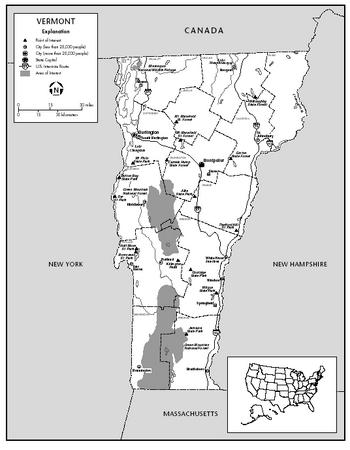Vermont
History
Vermont has been inhabited continuously since about 10,000 BC. Archaeological finds suggest the presence of a pre-Algonkian group along the Otter River. Algonkian-speaking Abnaki settled along Lake Champlain and in the Connecticut Valley, and Mahican settled in the southern counties between AD 1200 and 1790. In 1609, Samuel de Champlain crossed the lake that now bears his name, becoming the first European explorer of Vermont. From the 1650s to the 1760s, French, Iroquois Indians from New York, Dutch, and English passed through the state over trails connecting Montreal with Massachusetts and New York. However, few settled there. In 1666 the French built and briefly occupied Ft. Ste. Anne on Isle La Motte, and in 1690 there was a short-lived settlement at Chimney Point. Ft. Dummer, built in 1724 near present-day Brattleboro, was the first permanent settlement.

Governor Benning Wentworth of New Hampshire, claiming that his colony extended as far west as did Massachusetts and Connecticut, had granted 131 town charters in the territory by 1764. In that year, the crown declared that New York's northeastern boundary was the Connecticut River. Owners of New Hampshire titles, fearful of losing their land, prevented New York from enforcing its jurisdiction. The Green Mountain Boys, organized by Ethan Allen in 1770–71, scared off the defenseless settlers under New York title and flouted New York courts.
Shortly after the outbreak of the Revolutionary War, Ethan Allen's men helped capture Ft. Ticonderoga, and for two years frontiersmen fought in the northern theater. On 16 August 1777, after a skirmish at Hubbardton, a Vermont contingent routed German detachments sent by British General Burgoyne toward Bennington—a battle that contributed to the general's surrender at Saratoga, New York. There were several British raids on Vermont towns during the war.
Vermont declared itself an independent republic with the name "New Connecticut" in 1777, promulgated a constitution abolishing slavery and providing universal manhood suffrage, adopted the laws of Connecticut, and confiscated Tory lands. Most Vermonters preferred to join the US, but the dominant Allen faction, with large holdings in the northwest, needed free trade with Canada, even at the price of returning to the British Empire. Political defeat of the Allen faction in 1789 led to negotiations that settled New York's claims and secured Vermont's admission to the Union on 4 March 1791.
With 30,000 people in 1781 and nearly 220,000 in 1810, Vermont was a state of newcomers spread evenly over the hills in self-sufficient homesteads. Second-generation Vermonters developed towns and villages with water-powered mills, charcoal-fired furnaces, general stores, newspapers, craft shops, churches, and schools. Those who ran these local institutions tended to be Congregationalist in religion and successively Federalist, Whig, and Republican in party politics. Dissidents in the early 1800s included minority Protestants suffering legal and social discrimination, hardscrabble farmers, and Jacksonian Democrats.
Northwestern Vermonters smuggled to avoid the US foreign trade embargo of 1808, and widespread trade continued with Canada during the War of 1812. In September 1814, however, Vermont soldiers fought in the Battle of Plattsburgh, New York, won by Thomas Macdonough's fleet built at Vergennes the previous winter. The Mexican War (1846–48) was unpopular in the state, but Vermont, which had strongly opposed slavery, was an enthusiastic supporter of the Union during the Civil War.
The opening of the Champlain-Hudson Canal in 1823, and the building of the early railroad lines in 1846–53, made Vermont more vulnerable to western competition, caused the demise of many small farms and businesses, and stimulated emigration. The remaining farmers' purchasing power steadily increased as they held temporary advantages in wool, then in butter and cheesemaking, and finally in milk production. The immigration of the Irish and French Canadians stabilized the population, and the expansion of light industry bolstered the economy.
During the 20th century, and especially after World War II, autos, buses, trucks, and planes took over most passengers and much freight from the railroads. Manufacturing, especially light industry, prospered in valley villages. Vermont's picturesque landscape began to attract city buyers of second homes. Still rural in population distribution, Vermont became increasingly suburban in outlook, as new highways made the cities and hills mutually accessible, and the state absorbed an influx of young professionals from New York and Massachusetts. Tourism thrived, especially in the Green Mountains and other ski resort areas. Longtime Vermonters, accustomed to their state's pristine beauty, were confronted in the 1980s with the question of how much development was necessary for the state's economic health. The newcomers changed the political landscape as well. Whereas Vermont had long been dominated by the Republican Party, by the mid-1980s fully a third of the electorate voted Democratic. The Democratic presidential candidate carried Vermont in the 1988, 1992, 1996, and 2000 elections. In 1990, Vermont elected as its sole congressional representative a democratic socialist, Bernie Sanders, who called for reduced limits on campaign spending, a sharply progressive income tax, national health care, and 50% cuts in military spending over five years. Sanders's victory reflected, in part, voters' frustration with a downturn in the New England economy in the late 1980s. He was reelected in 2002.
In the early 1990s Vermont had the nation's highest percentage of women in its state legislature. With two-thirds of its population living in towns of 2,500 or fewer, it was the nation's most rural state. In 1993 Vermont passed legislation barring smoking in all public buildings, including most restaurants and hotels.
In 2003, Governor James H. Douglas, a Republican elected in 2002, pledged to create jobs and provide economic security to the state. He also emphasized higher education, and transportation spending. Douglas announced a substance abuse and interdiction program for Vermont's correctional facilities that would include random drug testing, including for those inmates out on furlough.